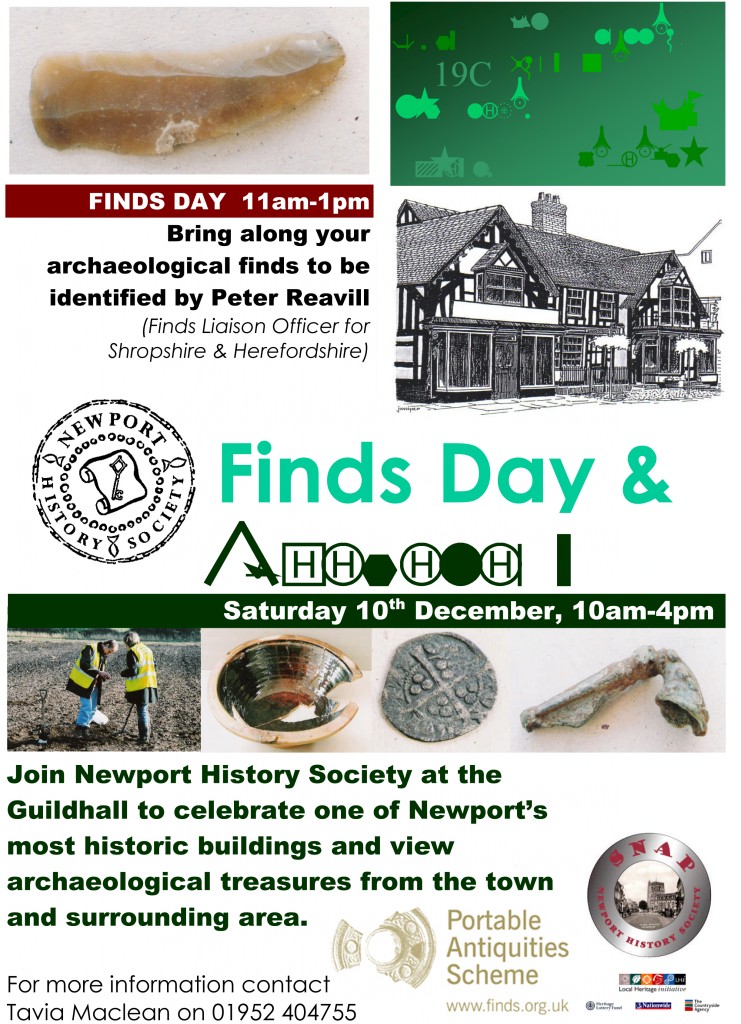Total posts:
187
05/22/2012
A rare Roman as has been recently found in Cheshire. The coin is a copper alloy as of Nerva, (96-98AD). It has been recorded on the database as LVPL-716282.
The coin is as follows:
Obverse: IMP NERVA CAES AVG P M TR P COS III PP; laureate head right.
Reverse: NEPTVNO CIRCENS[I? CONSTIT]VT S C; Neptune standing right, holding acrostolium in right hand and trident in left hand; to left small figure half-emerging from ground.
BMC 3 (1966) (Nerva, no. 132 and p. 553).
In 1984, Georges de Loye wrote about this type (Revue Numismatique 1984, pp. 95-103). He noted that 1 specimen was from France, another from Germany, but five from Britain (one in Oxford, one in Cambridge and three in the British Museum). Therefore, he surmised that this was an issue intended for use in Britain. This coin type was at one time regarded as a fake, and is categorised as such in RIC 2. It is, however, included in the revision of BMC 3 (1966) as genuine.
The most common Roman coin type found in Cheshire is the nummus, 231 of which have been recorded on the database from the area. Currently only 38 asses have been recorded from Cheshire four of which were found around Chester. It is very exciting to have such a rare coin recorded from the Chester area.
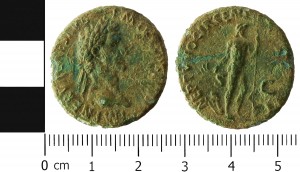
Roman as of Nerva
04/12/2012

Birmingham Museum and Art Gallery have organised a season of Sunday afternoon lectures on the Staffordshire Hoard. These lectures will address four very different aspects of the hoard from its initial discovery and study, the conservation work being undertaken, and what it all means for Mercia and Britain in the Early Medieval Period. It is expected that demand for places will be high so book early to avoid disappointment !!!
The Lectures:
Sunday 22nd April, 2pm-3pm
The Finding of the Hoard – the Early Days’ – A talk with Dr Kevin Leahy
In this talk Dr. Kevin Leahy, the National Adviser of Early Medieval Metalwork for the Portable Antiquities Scheme, discusses the exciting early days when the Hoard was discovered in a muddy field by a local metal detector, drawing upon the processes of finding archaeological material to uncovering its fascinating history.
Sunday 20th May, 2pm-3pm
Behind the Scenes at the Museum: Studying the Staffordshire Hoard
This talk is a rare opportunity to learn from the experts more about the Conservation of the Staffordshire Hoard. The talk will be led by Deborah Magnoler, a conservator working on the Hoard, and Dr. David Symons, Curator of Antiquities and Numismatics.
Sunday 22nd July, 2pm-3pm
Warfare and Violence: the Making of Mercia
During the Anglo-Saxon period Staffordshire, where the hoard was discovered, was the centre of the Kingdom of Mercia. Join Dr Morn Capper in this talk about the historical context behind the Staffordshire Hoard.
Sunday 18th August, 2pm-3pm
The Hoard as a Window onto England in the age of the Conversion to Christianity
In this talk Professor Nicholas Brooks delves deeper into the context of the Staffordshire Hoard, looking at how religion was going through a process of change during this period in Britain and how the Hoard pieces can illustrate these changes.
All talks will take place in the Waterhall, Birmingham Museum and Art Gallery
Tickets are £6 per person. Advanced booking is advised for these events.
To book your ticket contact the box office on 0121 303 1966 or book on-line at www.bmag.org.uk.
For further information please contact Julia Kirby (julia.kirby@birmingham.gov.uk or 0121 303 2836)
03/24/2012
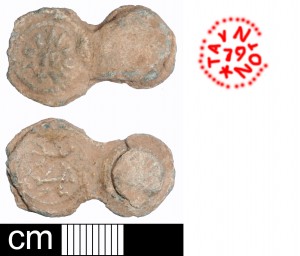
Cloth seals, although small and not much to look at, can give us fascinating insights into the Medieval and Post Medieval cloth trade, which was so important to economies of the period. This lead seal, SOM-B424B7, is of a form typical in England and some adjacent areas of the continent. It is formed of a row of four disks with tabs between. The row was bent in half over the edge of the cloth and a projecting point on one of the small outer disks went through the cloth then through a hole on the other outer disk before being stamped flat to rivet the ends together and to the cloth. The small disks appear plain apart from the raised circle from flattening the rivet. One larger disk is stamped with the legend *TAVNTON encircling 79 within a pellet border, the other has several faint raised lines, probably a ‘privy’ or ‘merchants’ mark.
Seals were attached to cloth at several stages of production. Personal seals might be added by the weaver and dyer, guild seals might also be added to show the quality of the work had been checked and it was of a required length and seals were added to show various taxes has been paid. This is almost certainly for serge cloth and Taunton seals with similar designs are known from the British Museum collections (Egan 1994: 51 and fig 23, no.97 and 98) and from Gloucester, Norfolk, Jamestown (Virginia) and Stockholm. It is suggested they are 17th century seals and the full date would read 1679, other dated examples include 1676, 1677 and 1674 (Egan ibid).
As cloth seals were discarded where the cloth was used, it is uncommon to find local seals (other seals from the same parish include a group from Ausburg, Germany). The VCH discussed the extensive cloth industry in Dunster and suggests: “The Dunster cloth industry spread to Carhampton before the end of the 16th century when clothiers, weavers and feltmakers were recorded. Weaver Edward Mills left two pairs of looms in 1635… and a weaver was recorded in 1713 but none thereafter” (Sireut 2010, Vol XII, in progress ). It is possible either that cloth from Taunton was consumed locally as well as exported or that Carhampton did not have its own mark but used the Taunton one and this seal was lost or removed before the cloth was exported.
02/24/2012
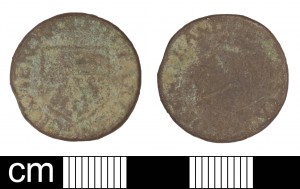
In the 17th century, small denominations of coinage were in short supply. This meant that day to day transactions, for instance buying a loaf of bread, became difficult. Following pilot schemes under Elizabeth I, copper farthings were issued officially under licence during the reigns of James I and Charles I. By the execution of Charles I in 1649, the shortage of small change was again severe (Dickinson, 1986, 4). It is at this point that unlicensed tokens began to be issued by private individuals.
Tokens were issued by local merchants and by local authorities, such as the constable of Taunton or the City of Wells. SOM-2DC917, a much worn token, is made of copper alloy. The legend reads ‘The farthing of a merchant// of the staple of England’ and depicts the arms of the Staple-Merchants on the obverse and a fleece on the reverse. The token is very unusual as it doesn’t give the location or name of the issuer.
The Staple managed the export of wool from the 1300’s and a merchant staple was the designated market for the wool trade in order to excise control over taxes and duties. By the 17th and 18th centuries, following export and import bans of raw wool and cloth, the Company of Merchants of the Staple of England was managing the wool supply within the UK, mainly confined to local markets.
This token provides a wonderful example of the role PAS can play in adding to the history of the country. Because this token, unlike most, doesn’t name the issuer or location and previous known examples are from historic collections rather than archaeological finds we don’t know where it was issued or by who. It could even have been an attempt to produce a generic type issued by several people in different locations which could be cashed in with any merchant of the staple. This token was found in Chedzoy, near Bridgwater and is the only example on the PAS database so far. Tokens do move through trade from their area of issue, but the find spots are usually confined to the surrounding counties. The find spot of this token, and similar ones found in future will help build the picture of where the token was issued and how widely it was traded.
For more information see Dickinson, M (1986) ‘Seventeenth Century Tokens of the British Isles and their Values’.
Katie Marsden
IfA/HLF Workplace Learning Bursary holder in Archaeological Finds in Somerset
Laura Burnett
Finds Liaison Officer for Somerset
02/17/2012
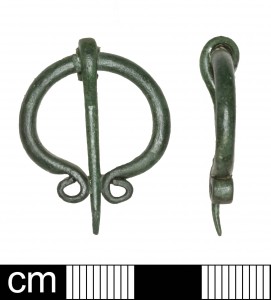
Iron Age to Roman penannular brooch from Wiltshire
The Portable Antiquities Scheme is a national scheme with one unified database. This makes research easier, bringing all records together in one place. It also means we can record finds from across the country and other Finds Liaison Officers regularly record things found in Somerset. This lovely brooch, SOM-629D01 is an example of a find from Alverdiston, Wiltshire with strong Somerset connections that can tell us something about local industries in the Iron Age and Roman periods.
The copper alloy brooch is a penannular type; an almost but not complete circle, and has a plain, undecorated frame and pin. The pin is also made from copper alloy and would once have moved freely around the frame but is now stuck in place with the tip over the gap in the frame. The brooch secured clothing by the pin being pushed through the fabric and out again, with the tip resting on the outside of the frame. Whilst the brooch has been in the ground, it has developed a dark green patina and would have been a simple but beautiful addition to the clothes it secured.
The ends of the frame coil outwards in a spiral and the way they do this makes this brooch very interesting. Most penannular brooches of this time terminate in either rounded knops (e.g. WILT-DA0C01) on the end of the frame, coils that rise up from the frame so that the loops are viewed from the side (e.g. SOM-E6EC36) or ‘omega’ ends that bend back from the frame, producing the shape of the Omega symbol (Ω) which gives them their name (e.g. KENT-5B4FA5). Our example has coils that are viewed from the top and are on the same level as the rest of the frame. This is the only example of a brooch with level coil terminals on the PAS database.
Brooches of this type are significant to the Somerset area. Fowler (1960, pg 157-158) suggests this brooch may have been a local derivative of Type Aa manufactured in the Weare and Glastonbury area. The findspot would seem to support this as it is only 30 miles away from Glastonbury.
Very few brooches of this type are found complete and unbroken which makes this example such a lovely find. This brooch has been dated to the first century BC or AD, a range of 200 years.
For more information, see Fowler, E., 1960 The origins and development of the Pennanular Brooch in Europe, Proceedings of the Prehistoric Society
Katie Marsden, IfA/HLF Workplace Learning Bursary holder in Archaeological Finds, Somerset.
12/06/2011
The Newport History Society have recently opened a new heritage centre in the heart of historic town of Newport, Shropshire. It is located next to the Medieval Guildhall at 3a The High Street.
To celebrate the opening of this new centre I will be running a finds identification session on Saturday (10/12/11) between 11am – 1pm at the Heritage Centre. If you have found an artefact, pottery, flint, or coins that you would like to know more about please come and see me. Those more than 300 years old I would like to borrow for a short time and record.
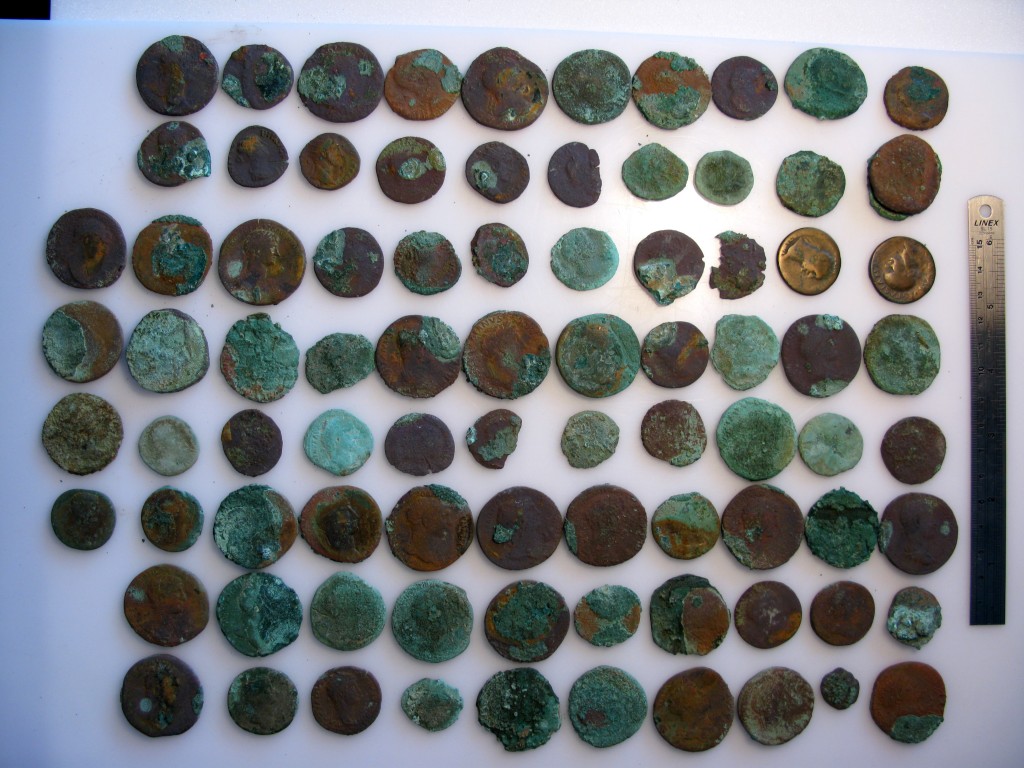
The heritage centre houses some of the society’s collections of archaeology and local history as well as many recent finds made by people from Newport. These include a small early Roman base metal coin hoard from Sherrifhales found by Terry Hayward of the Shropshire Search Society
Sherrifhales Coin Hoard
There will also be chance to see more recent discoveries from the Newport area. One of the most interesting recent finds (recorded by the PAS) is that of a silver half penny of Richard III struck between 1483 and 1485. This was found by Tony Baker whilst metal detecting in the Newport Area. Coins of Richard III are relatively rare, especially these half penny issues, but this is not why this coin is an exciting find. What really interests me is that it links us to other events locally at the time. Towards the end of the War of the Roses Newport supported Henry Tudor against Richard III. Supporters of Henry Tudor mustered troops near Newport, at a site now known as Muster Hill, before joining the massed armies marching towards the battle we know as ‘Bosworth Field’. The coin itself is pierced by a hole probably to allow it to be sown onto (or into) an item of clothing. The reasons for this are many; it may have been as a token of allegiance, a little like a badge. The fact that it is a coin that was readily available and not too expensive could suggest this; however due to the small size it is not that visible and spotting it is Richard III rather than Henry VI for example takes good eyesight. It may more likely have been pierced to conceal it or keep it safe in case of emergency. Low denomination pierced coins are most common from the English Civil wars of the mid 17th century. We can’t say whether this coin was owned or used by those who went to fight at Bosworth Field, but it acts as a reminder to a blood thirsty period in our history and the links that a small Shropshire market town has to these nation defining events.
Richard III Coin record
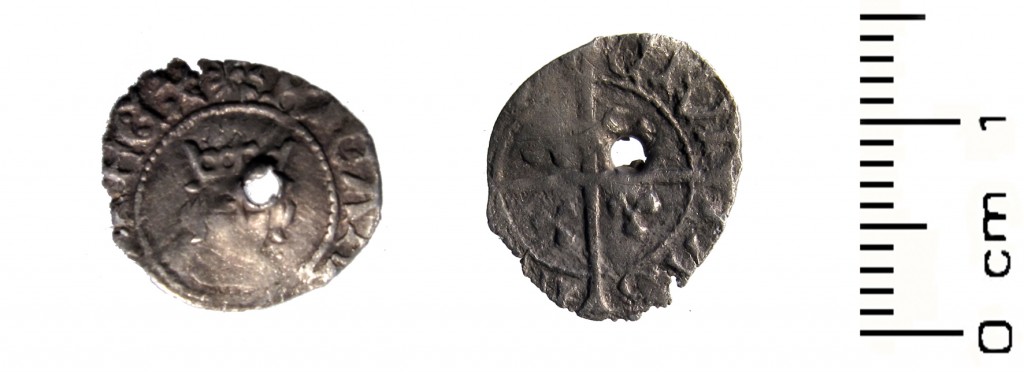
I hope that this will be the first of many visits and finds days to Newport.
For more information about Newport History Society see:
http://newporthistorysociety.org/
and for the new heritage centre see:
http://www.newportadvertiser.com/2011/10/21/heritiage-centre-gets-thumbs-up/
Finally, a good website that explains the key events of the War of the Roses can be seen here:
http://www.warsoftheroses.com
